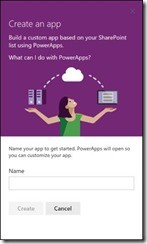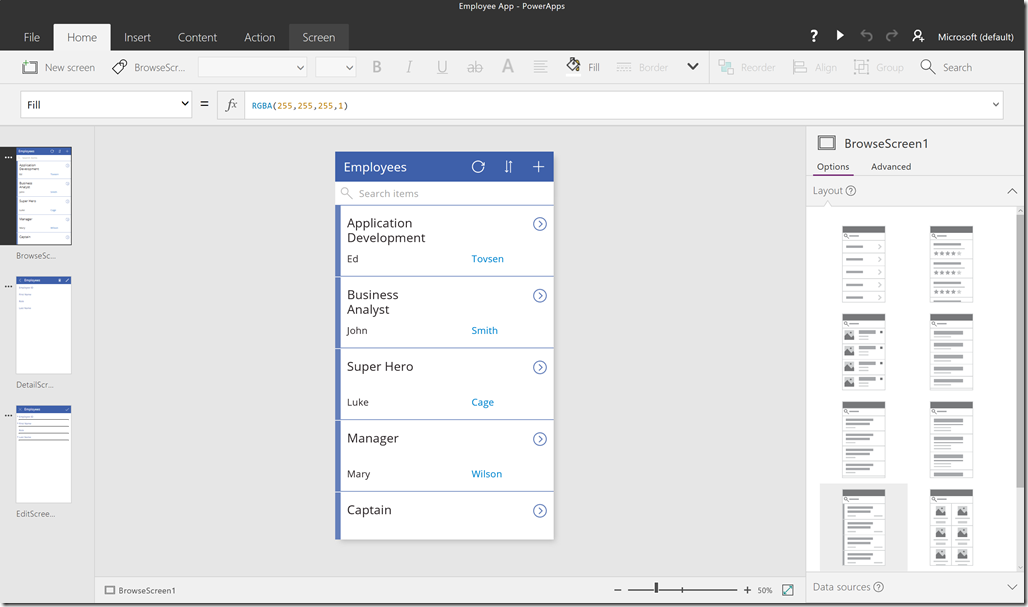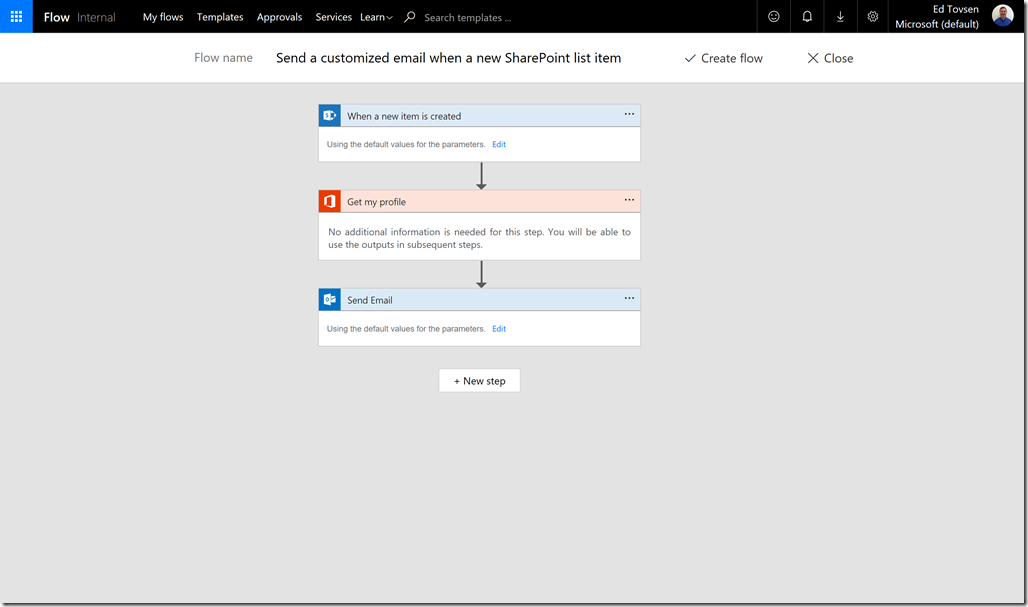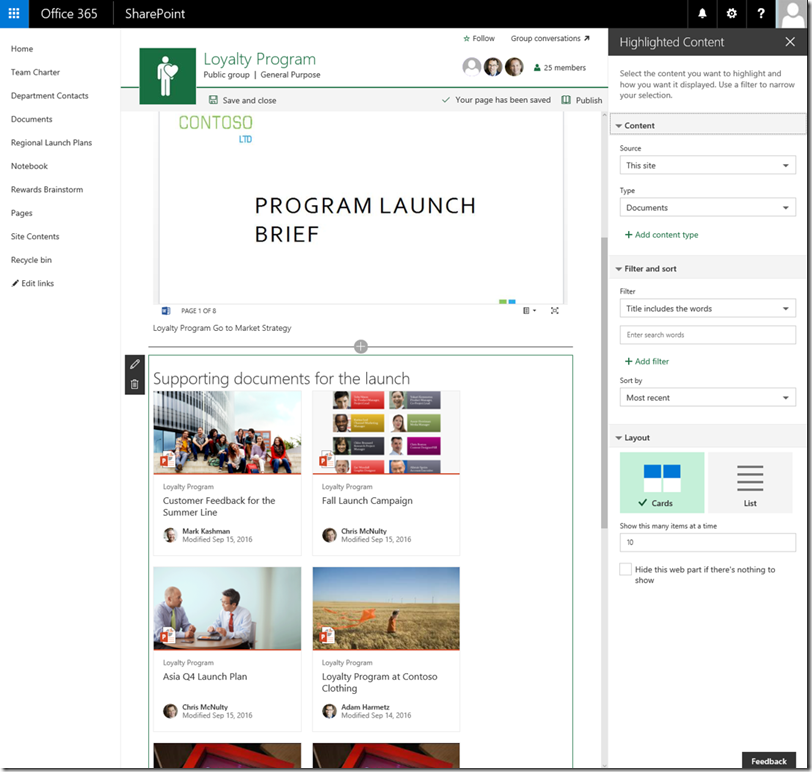This post is provided by Senior App Dev Manager, Ed Tovsen who highlights some of the new innovations available for SharePoint developers.
SharePoint development has evolved over the years since its initial release in 2001. Customization options have varied from fully trusted code, to sand-boxed solutions, to add-ins. With each new option, Microsoft has intended to simplify and control how customers customize their SharePoint environments. This past year Microsoft has continued innovating and introduced some new services and frameworks to expedite the customization of SharePoint environments. Two of the new services, PowerApps and Microsoft Flow, are designed for rapid custom development and deployment. Microsoft is finding that these types of services help developers and power users quickly tackle SharePoint requests, making SharePoint more useful and valuable for corporations. Additionally, Microsoft recently introduced a new client-side development model called SharePoint Framework (SPFx). Below are overviews for each of these new innovations and links to provide you with the specifics.
PowerApps
PowerApps is service built for developers and analysts to create online forms which connect to numerous data sources including SharePoint Online and SharePoint on-premises using a data gateway. Using either PowerApps Studio or the PowerApps web designer, you can quickly create apps that address specific needs without writing code or struggling with integration issues. PowerApps will generate custom apps that execute on all devices, including mobile, as well as the web. PowerApps is designed for a corporate environment where apps can be shared with employees.
PowerApps is tightly integrated with the new modern SharePoint experience. The modern SharePoint List menu includes a PowerApps button to create a new app for the current list. At this time, the modern SharePoint experience is only available in SharePoint Online. It will be included as part of an upcoming feature pack for SharePoint 2016.
 When you click on the Create an app, a pop-up will appear allowing for the app to be named. After the name is entered and the Create button clicked, the PowerApps web designer will open in the browser. Because the PowerApps web designer knows the context of the SharePoint list, it automatically creates a default app based on the schema and data of the SharePoint List. You can then customize the app to meet your business requirements.
When you click on the Create an app, a pop-up will appear allowing for the app to be named. After the name is entered and the Create button clicked, the PowerApps web designer will open in the browser. Because the PowerApps web designer knows the context of the SharePoint list, it automatically creates a default app based on the schema and data of the SharePoint List. You can then customize the app to meet your business requirements.
Apps created using these steps will be listed as a view and can be shared or launched from within the SharePoint modern list experience. This allows you to leverage PowerApps to build custom, mobile-optimized views of SharePoint lists and share them with co-workers. Lastly, PowerApps is a cross-platform service which allows apps to run on all devices including Windows, iOS, and Android.
Microsoft Flow
 Microsoft Flow is a service that allows developers and analysts to create automated workflows between applications and services which can synchronize files, get notifications, collect data, and more. Using templates or starting from scratch, developers create flows to turn repetitive tasks into multistep workflows. For example, you could get an email notification every time a new item is added to a SharePoint list. Microsoft Flow connects to both SharePoint Online and SharePoint on-premises using the same data gateway as PowerApps.
Microsoft Flow is a service that allows developers and analysts to create automated workflows between applications and services which can synchronize files, get notifications, collect data, and more. Using templates or starting from scratch, developers create flows to turn repetitive tasks into multistep workflows. For example, you could get an email notification every time a new item is added to a SharePoint list. Microsoft Flow connects to both SharePoint Online and SharePoint on-premises using the same data gateway as PowerApps.
Like PowerApps, Microsoft Flow is also integrated into the modern SharePoint List menu as you can see in the image above. When you click on the Create a flow, a pop-up will appear to create a flow for the SharePoint List. After selecting a template, the Flow web designer will open in the browser. Because the Flow web designer knows the context of the SharePoint list, it prefills the steps in the flow. You can then customize the flow to meet your business requirements.
Microsoft Flow is the successor to SharePoint Designer for common business scenarios such as approvals, document review, and onboarding/offboarding. Going forward, it will be the default tool for building business automation in SharePoint.
SharePoint Framework
The SharePoint Framework (SPFx) is a web part and page model that enables fully supported client-side development as well as support for open source tooling. Introduced in May 2016, the SharePoint Framework is initially focused on extending the SharePoint user interface using client-side web parts. SPFx aims to solve the difficulty of keeping up with the evergreen model of SharePoint Online. SPFx provides a standardized framework to create custom user interface extensions as well as building applications on top of SharePoint Online.
Microsoft built the SharePoint Framework from ground-up using a modern web stack including TypeScript / JavaScript, HTML, and CSS. All parts of the generated artifacts are executed locally in the browser. SPFx comes with a completely new set of tooling that is platform agnostic and works on either the PC or Mac. It is based on open source technologies such as Node.js, Gulp, Webpack, and Yeoman. The SharePoint Framework and tools are used at build time to streamline the developer experience for building, packaging, and deploying.
The SharePoint Framework runs in the context of the current user and connection in the browser, not using iFrames. The controls are rendered in the normal page Document Object Model (DOM) and are responsive and accessible in nature.
The SharePoint Framework reached General Availability (GA) in February 2017. Currently, the SharePoint Framework is only applicable for web parts running in SharePoint Online. Microsoft is planning to bring the SharePoint Framework to SharePoint 2016 on-premises during 2017, as part of a future feature pack. The SharePoint Framework roadmap also includes full page apps, which will render in full page mode and not as web parts in SharePoint.
Additional Information
- PowerApps Blog
- Generate an app from within SharePoint using PowerApps
- Microsoft Flow Blog
- SharePoint Framework (SPFx) enterprise guidance
Premier Support for Developers provides strategic technology guidance, critical support coverage, and a range of essential services to help teams optimize development lifecycles and improve software quality. Contact your Application Development Manager (ADM) or email us to learn more about what we can do for you.








0 comments